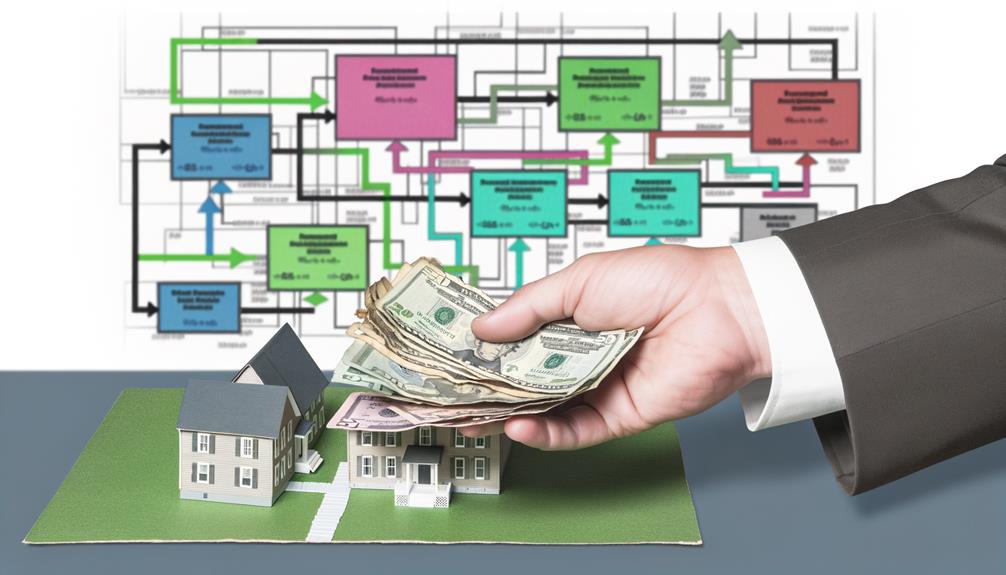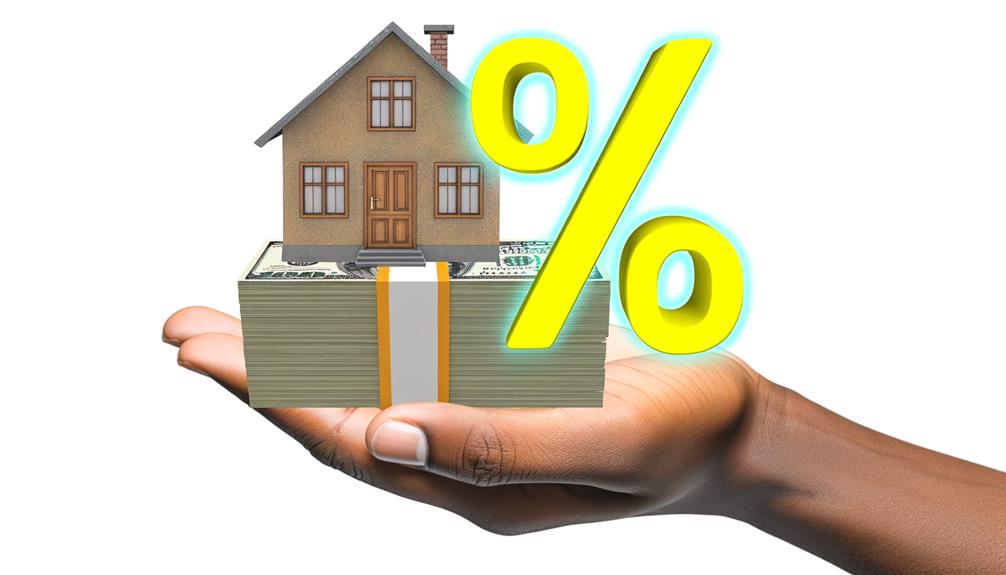Did you know that nearly 88% of home buyers finance their purchase with a mortgage, according to the National Association of Realtors?
When purchasing a home, one of the most crucial decisions you'll make involves determining how much cash to put down. The down payment can significantly impact your mortgage terms, monthly payments, and overall financial stability.
While a common notion suggests a 20% down payment is the standard, the reality may surprise you.
Stick around, there's a lot more to this that could reshape your home buying strategy.
Key Takeaways
- Down payment requirements vary based on the mortgage type, with first-time home buyers commonly making an 8% down payment and repeat buyers paying 19%.
- FHA loans require a minimum of 3.5% down, while VA and USDA loans may not require any down payment.
- The common misconception that a 20% down payment is required is not true, as the typical down payment for first-time home buyers is around 8%.
- Consider all options and weigh the benefits of lower upfront costs against potential interest payments and the cost of private mortgage insurance (PMI).
Understanding Down Payments
When you're preparing to purchase a house, it's critical to understand the concept of a down payment, which is an upfront cash payment typically expressed as a percentage of the total purchase price. This understanding down payments is vital in your home buying journey as payment requirements differ based on the mortgage type.
In 2023, first-time home buyers commonly made an 8% house down payment, while repeat buyers generally paid 19%. Different loans have specific down payment requirements. For instance, FHA loans require a minimum of 3.5% down, while VA and USDA loans may not require any.
It's important to note that these loans cater to particular groups: VA loans are for military service members and USDA loans are for rural and suburban home buyers. Both have specific eligibility requirements.
Also, remember that some conventional mortgages may require as little as 3% down payment. However, if you have enough cash, you could choose to make a larger down payment to reduce lifetime interest payments. Understanding how much down payment you can afford and what's ideal will significantly impact your success in buying a house.
The 20% Down Payment Myth
Building on the understanding of down payments, let's debunk a common misconception: the 20% down payment myth. You've probably heard that you need to put down 20% of a home's purchase price to buy a home. However, this isn't always true. The typical down payment for first-time home buyers is around 8%, and for repeat buyers, it's 19%.
You might be wondering, 'If I don't put down 20%, won't I be stuck paying private mortgage insurance (PMI)?' While a lower down payment may require PMI, it could also help you become a homeowner sooner. Options like VA and USDA loans even allow eligible individuals to secure a mortgage loan with no cash down at all.
As you navigate real estate agents and home listings, remember to consider all your options. A conventional loan isn't the only path to homeownership. Weigh the benefits of lower upfront costs against potential interest payments and the cost of PMI. In the end, you may find that the 20% down payment myth doesn't apply to your situation and that other options better fit your financial goals.
Minimum Down Payment Requirements

Navigating the world of down payments, you'll find that minimum requirements can vary greatly depending on the type of mortgage you're considering. For instance, a conventional mortgage typically requires a minimum down payment, whereas FHA loans require a 3.5% down payment if your credit score is 580 or above.
| Mortgage Type | Minimum Down Payment |
|---|---|
| Conventional | Varies, typically requires |
| FHA | 3.5% with a credit score of 580+ |
| VA | No down payment required |
| USDA | No down payment required |
For first-time home buyers, the average down payment in 2023 was 8%, while repeat buyers averaged 19%. However, payment assistance programs exist to help home buyers meet down payment requirements. Various factors such as your credit score, loan type, and whether you're a first-time buyer, can influence the minimum down payment. It's crucial to understand these nuances to prepare for the financial commitment of homeownership. Remember, while some loans like VA loans do not require a down payment, others like conventional and FHA loans do. Make informed decisions to ensure your journey to homeownership is smooth and successful.
Benefits of Larger Down Payments
You might be wondering why it's beneficial to increase your down payment when buying a house.
Consider this: a larger down payment leads to lower monthly mortgage payments and helps you build equity faster.
This can translate into significant financial benefits in the long run.
Lower Mortgage Payments
Putting down a larger sum on your house purchase not only provides you with higher initial home equity, but also leads to more manageable monthly mortgage payments. This is because the payment on a house is divided into the mortgage interest rate and the principal payment. The higher your down payment, the smaller your loan amount, and thus the lower your monthly mortgage payment.
With a larger down payment, you borrow less and therefore pay less interest over the life of the loan. Lower down payments might seem attractive initially, but they result in higher monthly payments. By investing a larger down payment, you're essentially securing a lower payment amount for the future, making your mortgage payments more affordable and your home's purchase price more manageable.
Greater Equity Buildup
While ensuring lower mortgage payments is one significant advantage of putting more cash down for a house, it's also worth noting that this practice accelerates your equity buildup, giving you a bigger stake in your home from the outset. This greater equity buildup happens because:
- A large down payment means a smaller loan balance, reducing the amount you owe.
- It hastens the process to buy a house without a mortgage, eliminating loan interest.
- It increases home equity, which is your home's value minus the outstanding loan balance.
- Lastly, it helps pay off your mortgage faster, freeing your finances for other investments.
In essence, a larger down payment provides a quicker path to full ownership, creating a sense of truly belonging in your new home.
Deciding Your Down Payment Amount

Determining the right down payment amount for your house can be influenced by several factors, including its effect on your monthly mortgage payments, affordability, available loan options, and your overall financial situation. When deciding your down payment amount, it's crucial to consider how much cash down for a house you can realistically afford.
For instance, you might choose to put down less if your money comes from an unstable source or if you have other large expenses. Conversely, a higher down payment can lead to lower lifetime interest payments and smaller monthly payment amounts. This could be a smart choice if you have a stable income and can afford to put more money upfront.
Remember, the key is to determine how much you need to put down while ensuring it aligns with your financial comfort zone. Assessing loan options is equally important. For example, Conventional loans may require as little as 3% down, while VA and USDA loans don't require any down payment.
Ultimately, the down payment amount you choose should be a decision that allows you to maintain financial stability. Make sure to thoroughly evaluate your options before making your choice.
Factors Influencing Down Payments
When considering your down payment for a house, it's essential to understand the factors that can influence your decision.
Your credit score, the type of loan you're considering, and the conditions of your local market can all significantly impact your down payment amount.
Let's take a closer look at each of these variables to better equip you in your home-buying journey.
Credit Score Impact
Undeniably, your credit score wields a significant influence on the down payment required for a mortgage, making it a critical factor to understand when planning to purchase a home.
- Minimum Credit Score: Mortgage lenders typically require a minimum credit score. The higher your credit scores, the lower the down payment necessary.
- Loan Amount: The loan amount you require can impact the down payment. Larger loans may necessitate higher credit scores.
- Interest Rates: A lower credit score might increase your interest rates. Higher credit scores can lead to a lower interest rate, reducing the overall payment to buy a home.
- Federal Programs: Organizations like the Federal Housing Administration and Department of Veterans Affairs may have lower credit score requirements, easing the credit score impact on the required down payment.
Loan Type Differences
Diving into the realm of home loans, you'll find that the type of loan you choose can significantly impact your down payment, with options ranging from conventional loans to government-backed programs. Understanding these loan type differences is key when figuring out how much cash down for a house.
Conventional loans, backed by Federal Housing Finance, usually require down payments of 3-5%. However, different types of mortgages like VA and USDA loans cater to specific groups and may not require down payments.
Local Market Conditions
Beyond understanding loan types, you'll also need to consider local market conditions which can significantly influence the down payment required when purchasing a house.
As new home buyers, be aware that:
- The homes sale price can fluctuate based on housing demand and inventory.
- High demand markets may require larger down payments.
- Conversely, sellers may be more flexible in buyer's markets.
- Economic factors like local job stability and interest rates can impact down payment expectations.
To figure out how much you can afford, refer to the National Association of Realtors' affordability calculator. This tool considers your median income and the price of primary residences in your area. Even lenders like Rocket Mortgage provide resources to help you understand these factors.
Buying a House Without Down Payment
Often, you may find the prospect of buying a house without a down payment quite appealing, especially with options like Veterans Affairs (VA) and Department of Agriculture (USDA) loans that require no down payment, or programs like the ONE+ from Rocket Mortgage that only requires a 1% down payment.
Government-backed mortgage programs such as VA or USDA loans are designed to make homeownership more accessible. If you qualify for a VA or USDA loan, you could avoid the question of how much cash down for a house entirely. If you're not eligible for these programs, but still want to put less down, other programs offered could help. HomeReady and Home Possible, for instance, are designed to help lower-income and first-time homebuyers, respectively.
However, it's important to remember that while buying a house without down payment can expedite your path to homeownership, it may also result in higher lifetime interest payments, so consider all factors before deciding. Your dream of belonging in your own home is important, but financial stability should be considered as well.
Down Payment and Mortgage Loans

While exploring options for buying a house without a down payment can be appealing, it's crucial to understand the ins and outs of down payments and mortgage loans to ensure you're making the best decision for your financial future.
Here's what you need to know:
- Down Payment: This is the initial cash you put down when buying a house. Typically, first-time buyers put down 8%, while repeat buyers usually put down 19%.
- Mortgage Loans: These are loans used to buy a house. Some loans, like VA and USDA loans, don't require any down payment.
- Conventional Loans: These types of loans require a down payment. The amount varies, but it's often around 20% of the house's purchase price.
- Pros and Cons of 20% Down: Putting 20% down can eliminate the need for private mortgage insurance and secure you lower interest rates, providing long-term savings. However, it might take longer to save this much money, potentially delaying your home purchase.
Understanding these elements will help you navigate your home buying journey efficiently and confidently, ensuring you feel a sense of belonging in your new home.
Saving for Your Down Payment
Now that you're familiar with the basics of down payments and mortgage loans, let's dive into strategies for saving up for your down payment – a key step in your journey to homeownership.
The first step in this process is understanding 'How Much Do You Need' to save. This depends on several factors, including the type of mortgage and how much cash down for a house you're comfortable with.
You need to pay attention to the ongoing costs of homeownership as well, to ensure that your monthly payments are manageable. This will help you determine how much you need to save for your down payment. Your aim should be to save enough money to make homeownership a reality without straining your finances.
Strategies for saving for your down payment can range from cutting expenses, seeking down payment assistance programs, exploring low down payment options, and even borrowing or withdrawing from a retirement account. Remember, the goal is to make homeownership possible while maintaining a healthy financial lifestyle.
As you navigate this journey, always keep in mind the balance between saving for your down payment and managing your ongoing expenses.
Assessing Your Home Affordability

To accurately assess your home affordability, it's crucial to consider your income, debts, monthly expenses, and your projected down payment, ensuring you're financially prepared for this significant commitment. As you embark on the journey of homeownership, you need to have a clear understanding of how much house you can afford based on your financial situation.
- Income and Monthly Pay: Your income will play a large role in your ability to secure home loans. It also determines how much of your monthly pay you can comfortably allocate to housing expenses without straining your budget.
- Debts: Outstanding debts can limit the amount you're eligible to borrow, affecting your home affordability. Strive to minimize debts to increase your borrowing capacity.
- Credit Score: A good credit score can make a large difference in the interest rates on your home loan, directly impacting your monthly payments.
- Down Payment: The larger the down payment you're capable of putting down, the lower your loan amount will be, resulting in lower monthly payments.
Frequently Asked Questions
Is $10,000 Enough to Put Down on a House?
Yes, $10,000 can be enough for a down payment, depending on loan eligibility, housing market trends, and your financial stability. However, consider homeownership costs, mortgage insurance, and your debt to income ratio.
How Much Cash Should You Put Down on a House?
You should consider down payment options, monthly mortgage impact, saving strategies, and your financial stability. Market trends, your credit score, loan types, interest rates, homeowner insurance, and negotiation leverage also factor into the decision.
How Much Is the Down Payment on a $200 000 House?
For a $200,000 house, you'd typically put down 20%, or $40,000. However, depending on your loan type and financial situation, you could potentially put down as little as 3%, which would be $6,000.
Is It Worth Putting 20 Down on a House?
Yes, it's worth considering. A 20% down payment eliminates mortgage insurance, improves credit scores, secures lower interest rates, and provides immediate equity, lower payments, and greater financial security. It also boosts budget management and investment opportunities.
Conclusion
In a nutshell, deciding how much cash to put down for a house isn't a walk in the park. It requires careful consideration of your financial situation, mortgage type, and long-term goals.
While 20% is often touted as the golden rule, there are many routes to homeownership. Remember, the best choice is always the one that leaves you financially comfortable and secure.
Getting a handle on your finances can be the key to unlocking your dream home.


